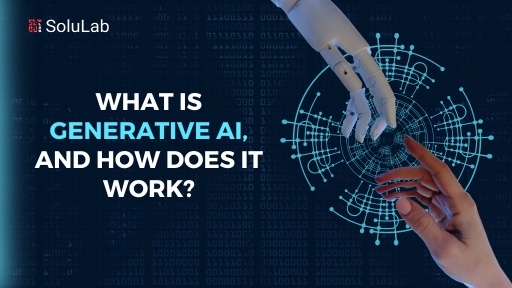Generative AI development has become one of the most fascinating and promising fields of artificial intelligence in recent years. The technology allows machines to generate new and unique content, such as images, music, videos, and text, without human intervention. This capability has numerous practical applications, including content creation, design, and even healthcare. In this article, we will delve into the topic of generative AI, its working principles, its applications, and its development.
What is Generative AI?
Generative AI is a subset of artificial intelligence that uses deep learning models to generate new data that resembles the input data. Unlike traditional AI models that rely on pre-existing data to make predictions, generative AI can create new data that does not exist in the original dataset. This capability is achieved through generative models, which are neural networks trained on large datasets to learn the patterns and relationships in the data.
Generative AI is a type of unsupervised learning, which means that the model is not given a specific task or objective to achieve. Instead, the model learns to generate data that is similar to the input data by optimizing a loss function. The loss function measures how well the generated data matches the input data, and the model adjusts its parameters to minimize the loss function.
How Does Generative AI Work?
Generative AI uses deep learning models to generate new data that resembles the input data. The models are trained on large datasets to learn the patterns and relationships in the data. There are several generative models, including autoencoders, variational autoencoders (VAEs), and generative adversarial networks (GANs).
Autoencoders
Autoencoders are neural network that learns to reconstruct the input data. The model consists of an encoder that compresses the input data into a lower-dimensional representation and a decoder that reconstructs the input data from the compressed representation. Autoencoders can be used for data compression and denoising.
Variational Autoencoders
Variational autoencoders (VAEs) are a type of generative model that extends the basic autoencoder architecture. VAEs generate new data by sampling from a probability distribution, which is learned during training. The model consists of an encoder that compresses the input data into a lower-dimensional representation, a decoder that reconstructs the input data from the compressed representation, and a probabilistic decoder that generates new data by sampling from the learned probability distribution.
Generative Adversarial Networks
Generative adversarial networks (GANs) are a type of generative model that consists of two neural networks: a generator and a discriminator. The generator generates new data that resembles the input data, and the discriminator evaluates the quality of the generated data. The generator learns to generate better data by optimizing a loss function that measures how well the discriminator can distinguish between the generated data and the input data.
Applications of Generative AI
Generative AI has numerous practical applications in various fields, including content creation, design, and healthcare.
Content Creation
Generative AI can be used for content creation, such as generating images, videos, and music. For example, AI-generated music has been used in video games and film soundtracks. AI-generated images and videos can be used for virtual reality and augmented reality applications.
Design
Generative AI can also be used for design applications, such as creating logos, website layouts, and product designs. For example, AI-generated logos have been used by companies such as Airbnb and OpenAI.
Healthcare
Generative AI can also be used in healthcare for drug discovery and medical imaging. For example, AI-generated molecules can be used to discover new drugs and AI-generated medical images can be used for diagnosis and treatment.
Conclusion
Generative AI is a fascinating field of artificial intelligence that has the potential to revolutionize many industries. The ability to generate new and unique data has numerous practical applications in content creation, design, and healthcare. The technology is still in its early stages, and there is much to learn and explore.
Read also: Top 10 Generative AI Development Companies
However, there are also some potential ethical concerns associated with generative AI. For example, AI-generated content can spread fake news and propaganda, and AI-generated images and videos can be used maliciously. It is essential to be aware of these risks and to develop appropriate safeguards and regulations to prevent misuse.
In conclusion, generative AI is a powerful tool that can potentially transform many industries. The technology allows machines to generate new and unique data that resembles the input data without human intervention. While there are potential ethical concerns, the benefits of generative AI are numerous and significant. As technology continues to develop, it is crucial to be aware of its potential risks and to take appropriate measures to ensure that it is used ethically and responsibly.


No comments yet